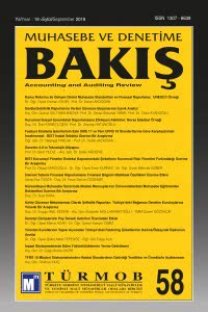Muhasebe meslek mensuplarının mesleki tükenmişlik düzeyinin yaşam doyumu üzerine etkisi: aydın ili örneği
Bu çalışmada bireyin işinden soğuması ve yaptığı işe eskisi kadar değer vermemesi anlamına gelen mesleki tükenmişlik, bireyin yaşam kalitesi hakkında ulaştığı yargıları temsil eden yaşam doyumu kavramları ve bu kavramların birbirleriyle olan ilişkileri incelenecektir. Çalışmada, muhasebe meslek mensuplarının mesleki tükenmişlik düzeylerinin saptanması ve tükenmişlik düzeyi ile yaşam doyumları arasındaki ilişkinin ortaya konulması amaçlanmaktadır. Araştırma, Aydın ilindeki serbest muhasebeci mali müşavirler üzerinde yapılmıştır. Çalışmada veri setinin oluşturulması amacıyla anket formu kullanılmıştır. Muhasebe meslek mensuplarının tükenmiş- lik düzeylerini belirlemek amacıyla Maslach ve arkadaşları (1982) tarafından geliştirilen ve 22 maddeden oluşan Maslach Tükenmişlik Ölçeği (MBI) kullanılmıştır. Yaşam doyumu ise, Diener (1985) tarafından geliştirilen ve 5 maddeden oluşan Yaşam Doyumu Ölçeği ile ölçülmüştür.
The influence of burnout levels of the accounting professionals on the life satisfaction: the city of aydin example
This study investigates the interaction amongst the Professional burnout, referring to detachment of the individual from the job and not giving as much as value he/she used to giveforth which are thought to be a representing the overall judgments of a person about the quality of his/her life. The purpose of the study is to assess the level of burnout for accounting Professionals and investigate the inf- luence of burnout dimensions on the level satisfaction with life. Certified Public Accountants working in Aydin participated in this study. Questionnaire is used to form the data set. The burnout level of the accountant professionals was measured using 22 item Maslach Burnout Scale developed by Maslach and her colleagues (1982) and Life satisfaction is measured using 5-item The Satisfaction With Life Scale developed by Diener and et.al (1985).
___
Anand, M.; Arora, D., Burnout, Life Satisfaction and Quality of Life among Executives of Multi National Companies, Journal of the Indian Academy of Applied Psychology, vol. 35, no.1, January 2009.Anvari, M.,Kalali, N., Gholipour, A., How Does Personality Affect on Job Burnout?, International Journal of Trade Economics and Finance, vol. 2, no. 2, April 2011.
Arı, G. S., Bal, H., Bal, E. Ç., İşe Bağlılığın Tükenmişlik ve İşten Ayrılma Niyeti İlişkisindeki Aracılık Etkisi: Yatırım Uzmanları Üzerinde Bir Araştırma, Süleyman Demirel Üniversitesi İİBF Dergisi, c. 15, s. 3, 143-166, 2010.
Avşaroğlu, Deniz, Kahraman, Teknik Öğretmenlerde Yaşam Doyumu İş Doyumu ve Mesleki Tükenmişlik Düzeylerinin İncelenmesi, 2006,
http://web.firat.edu.tr/sosyalbil/dergi/arsiv/cilt17/sayi1/115130.
Cakınberk, A. Studying the Relationship between Employees Occupational Burnout Levels and Satisfaction of Life: A Research in Private Banks, African Journal of Business Management, vol. 5(16), August 2011.
Cordes, C. L., T. W., Dougherty, A review and an integration of research on job burnout, Academy of Management Review, 18(4), 621656, 1993.
Demerouti, E., Bakker, A., Nachreiner, F., Schaufeli, W., A Model of Burnout and Life Satisfaction Amongst Nurses, Journal of Advanced Nursing, 2000, 32(2), 454-464.
Dyrbye, L. N., Thomas, M. R., Massie, F. S., Power, D. V., Eacker, A., Harper, W., Burnout and suicidal ideation among U.S. medical students Academic And Clinic, Annals of Internal Medicine, 149 ,334-341, 2008.
Etziyon, D., Pines, A., Sexond Culture in Burnout and Coping Among Human Sevice Professionals, Journal of Cross Cultural Psychology, 17,2, 191-209, 1986.
Gündüz, B., Capri, B., Gökçakan, Z., Mesleki Tükenmişlik, İşle Bütünleşme ve İş Doyumu Arasındaki İlişkilerin İncelenmesi, Eğitim Bilimleri Araştırmaları Dergisi, cilt 3, sayı 1, Nisan 2013.
Jackson, S.E.,Schwab, R.L., Schuler, R.S., Toward an Understanding of the Burnout Phenomenon, Journal of Applied Psychology, 71(4), 630-640, 1986.
Khan, M., Zaheer, A., Malik, M., Developing and Testing a Model of Burnout at work and Turnover Intensions among Doctors in Pakistan, International Journal of Business and Management, vol. 5, no. 10, October 2010.
Lee, R.T., Ashforth, B. E., A Further Examination of Managerial Burnout: Toward an Integrated Model, Journal of Organizational Behaviour, 9(4):297-308, 1993.
Lee, R.T., Ashforth, B. E., On the Meaning of Maslachs Three Dimensions of Burnout, Journal of Applied Psychology, 75 (6), 743-747, 1990.
Maslach, C., Goldberg, J., Prevention of Burnout: New Perspectives, Applied & Preventive Psychology, 7:63- 74, 1998.
Maslach, C., Jackson, S., The Measurement of Experienced Burnout, Journal of Organizational Behaviour, vol 2, no. 2, 99-113, August 1981.
Maslach, C.,Schaufeli, W., Leiter, M., Job Burnout, Annual Review Psychology, 52: 397-422, 2001.
Onay, M., Kılcı, S., İş Stresi ve Tükenmişlik Duygusunun İşten Ayrılma Niyeti Üzerine Etkileri: Garsonlar ve Aşçıbaşılar, Organizasyon ve Yönetim Bilimleri Dergisi, cilt 3, s. 2, 363-372, 2011.
Rostami, Z., Abedi, M.R.,Dose Academic Burnout Predicts Life Satisfactionor Life Satisfaction is Predictor of Academic Burnout? Interdisciplinary Journal of Contemporary Research in Business, vol. 3, no. 12, April 2012.
Senterv.d., Correctional Psychologist Burnout, Job Satisfaction and Life Satisfaction, American Psychological Association, vol. 7, no. 3, 190-201, 2010.
Serin, N., B., Aydınoğlu, N., Investigation of Life Satisfaction Predictors of School Counsellors, Eurasian Journal of Educational Research, Issue 53/A, 2013, 345-360
Sipahi, B., Yurtkoru, S., Çinko, M., Sosyal Bilimlerde SPSSle Veri Analizi, Beta Yayınları, İstanbul, 2008.
Şeker, B., Zırhlıoğlu, G., Van Emniyet Müdürlüğü Kadrosunda Çalışan Polislerin Tükenmişlik, İş Doyumu Ve Yaşam Doyumları Arasındaki İlişkilerin Değerlendirilmesi, Polis Bilimleri Dergisi, c. 11,4, 2011.
Keser, A., İş Doyumu ve Yaşam Doyumu İlişkisi: Otomotiv Sektöründe Bir Uygulama, Çalışma ve Toplum, S.4, 2005.
Waugh, C.K.,Judd, M.R., Trainer Burnout: The Syndrome Explored, Journal of Careerand Technical Education, vol. 19, no.2, 47-57, Spring 2003.
Wright, T.A., Bonett, G.D., The Contribution of Burnoutto Work Performance, Journal of Organizational Behavior, 18, 491-499,1997.
- ISSN: 1307-6639
- Yayın Aralığı: Yılda 3 Sayı
- Başlangıç: 2000
- Yayıncı: TÜRMOB
